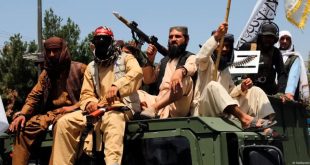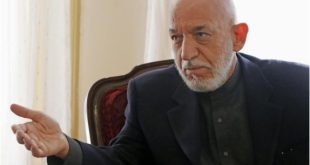By Rebecca Kheel-President-elect Donald Trump’s pledges to end the nation-building missions of the military will be tested in Afghanistan, where President Obama repeatedly came up against the reality of a country unready for U.S. forces to leave.
Trump will inherit a military drawing down in Afghanistan to 8,400 troops, well above the 1,000 Obama originally wanted to leave at just the U.S. embassy in Kabul.
Obama formally ended the combat mission in 2014, but U.S. troops remain on a dual mission.
One is to conduct counterterrorism strikes against groups such as al Qaeda and the Islamic State in Iraq and Syria. The other is to train, advise and assist Afghan forces in their fight against the Taliban, a mission critics have called nation-building.
Facing a resilient Taliban and recommendations from his military advisors not to withdraw, Obama was twice forced to increase the number of troops he planned to leave in country after this year, first to 5,500 then to 8,400.
Trump could likely face the same issue.
“Afghanistan is inherently and profoundly mixed as a mission,” said Michael O’Hanlon, a senior fellow at the Brookings Institution. “I think in the end, his view, given that it provides a counterterrorism platform, will probably be that it’s worth keeping that level of investment.”
In its latest biannual report on the security situation in Afghanistan, the Pentagon said the Taliban is in control of or has influence over 10 percent of the country and is contesting the government for another 20 percent. U.S. officials have said the Taliban holds more ground than at any point since it was ousted from power in 2001.
The report, released earlier in December, also said the Afghan National Defense and Security Forces (ANDSF) continue to need the help of U.S. and NATO forces.
“Although the ANDSF denied the insurgency any strategic successes, the ANDSF have also demonstrated the need for continued U.S. and coalition support to address persistent capability gaps and deficiencies,” the report says.
Nine U.S. soldiers were killed in action in Afghanistan this year, including three soldiers killed in the first suicide bombing inside the walls of the heavily guarded Bagram Airfield since U.S. troops arrived in the country.
Trump spoke with Afghan President Ashraf Ghani via telephone on Dec. 2. They discussed the “grave terrorism threats facing both countries and pledged to work more closely together in order to meet these growing threats,” according to a brief statement from Trump’s transition team.
Ghani also signaled his desire for the U.S. to keep a strong presence in Afghanistan, stressing “that the joint war against terrorism has made America a foundational partner to the people of Afghanistan.” He said U.S. investments in his country “are bearing fruit,” according to a statement from the Afghan embassy in D.C.
Afghanistan was barely mentioned in the presidential campaign. It came up just once in the debates when Hillary Clinton made a passing reference to it while discussing NATO’s reaction to 9/11.
Trump appears to have last talked publicly about Afghanistan in October 2015 — and in his comments he has contradicted himself.
In an Oct. 6, 2015, interview with CNN, he called it a mistake to go into Afghanistan in the first place, but said the president would have little choice but to keep troops there.
“At some point, are they going to be there for the next 200 years?” Trump said. “We made a terrible mistake getting involved there in the first place. We had real brilliant thinkers that didn’t know what the hell they were doing. And it’s a mess. It’s a mess. And at this point, you probably have to [stay] because that thing will collapse about two seconds after they leave.”
Two weeks later, in another interview with CNN, Trump backtracked on calling Afghanistan a mistake, saying he “never said that.”
He did reiterate that U.S. forces need to stay.
More recently and more frequently, Trump has spoken broadly about the need to end nation-building.
“Our current strategy of nation-building and regime change is a proven failure,” he said in an August speech on terrorism. “If I become president, the era of nation-building will be ended. Our new approach, which must be shared by both parties in America, by our allies overseas and by our friends in the Middle East, must be to halt the spread of radical Islam.”
Any attempts to curtail the mission in Afghanistan could be met by opposition from his choice for Defense secretary, retired Gen. James Mattis.
Mattis rose to national prominence in 2001 as the then-one-star general who led an amphibious task force of Marines that carried out the raid on Kandahar province in Afghanistan.
As commander of Central Command, Mattis recommended Obama keep 13,600 troops in the country after the end of the combat mission, thousands more than the 9,800 troops Obama eventually settled on.
“I think we have to send a message of commitment,” Mattis said at the March 2013 Senate Armed Services Committee hearing where he revealed his recommendation.
In August, Mattis spoke about the need to stay engaged in the Middle East beyond the battlefield, just as the United States did in Europe after World War II.
“We created the Marshall Plan, three years after Nazis were burning Jews,” Mattis said at a speech Washington State University, according to local media. “We offered them locomotives, rail lines, anything to help get their economies going again. That’s the greatest generation. The point is it’s more than just fighting battles.”
O’Hanlon, the Brookings fellow, said Mattis, having retired from the military three years ago, will likely need to take a new look at Afghanistan when he assumes the role of Defense secretary.
“He’s probably going to go look at Afghanistan with fresh eyes, as he should,” O’Hanlon said.
But, O’Hanlon added, his sense is Mattis’s experience makes him likely to see the value in maintaining troop levels.
O’Hanlon also said he wouldn’t classify Afghanistan as nation-building, particularly since it’s a term “full of baggage,” but that Trump could press the issue if he so desires.
“If President Trump wanted to make it into an issue, he could,” O’Hanlon said. “It still costs $15 billion a year and there are still several Americans killed. But it’s a central location where you can attack al Qaeda and ISIL, operate drones, conduct surveillance, conduct commando raids if need be. That’s pretty useful.”
Sean McFate, a senior fellow at the Atlantic Council, said that based on Trump’s derision of nation-building, he could foresee Trump abandoning the mission of training, advising and assisting conventional Afghan forces, though he could envision Trump trying to build small, elite Afghan counterterrorism forces.
But, he added, Trump “sent mix messages during his campaign.”
McFate also said he thinks the public would back any Trump decision to curtail the Afghanistan mission.
“I think the American people are tired with perpetual boots on the ground with nothing to show,” McFate said. “Fifteen years have yielded precious little results.”
Still, drawing down remains a balancing act, he said.
“The U.S. needs to get out,” he said. “What we’re all worried about is, is there a way to do that to minimize risk to the U.S., and can you do that without it being a propaganda coup to the Taliban.”—(The Hill)
 Afghanistan Times
Afghanistan Times



